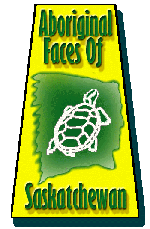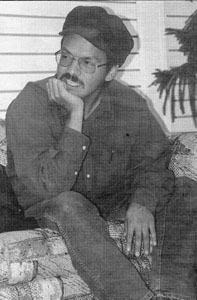|
 |
||||||||
Theatre artist stretches limits of Native drama By Pamela Green Reprinted with
permission from
Favel has received numerous awards and grants, which included a trip to Japan to study with the Suzuki Company of Toga, under Butoh master N. Nakajima. Butoh is a dramatic dance-movement style developed in Japan, which emphasizes very slow and controlled body movements. With all this international theatrical background behind him, Favel is blazing a new trail, and laying the foundation for a better understanding of Native performance art. Favel explained that the artistic inspiration for Native performance art must come from the source by "developing the performance practices of our ancestors." He said that this is "a process that reduces Native songs and dances to their bare essentials, which are the basic building blocks that will become the starting points for a creative and vital action, whose source is not transplanted and colonial." Favel compares this to journeying upstream to find the source of the river, and that the source of art must come from the heart of the culture. In Favel's theatrical world, however, the stage is not merely a powwow ground. It's something more dynamic and stylized. Favel's dramatic art will draw inspiration from ceremonial life, but will not exploit the traditional rituals on stage. The Native artist faces a dilemma. He must preserve the heart and centre of ceremonial life while never revealing it or showing it, and yet be visibly transformed and revitalized by it, Favel said. "It is not for nothing that our old shamans say, 'This is not for show, do not sell this,'" he explained. Favel is the director of the Red Tattoo Ensemble in Regina, the Takwakin Theatre in Edmonton, and founder of the Native Theatre Workshop, which is one of two specialized training programs in Canada. He also has a long-term goal to "rehearse on the reserve." Favel wants to bring other artists and friends into a very comfortable and dynamic Native environment, because, he explained, "everything doesn't have to be centralized in big cities." Favel feels that it's very important to pick a venue for Native theatre that's culturally friendly, and affordable to young artists and actors. "And as a Native artist, you want to do something for your family and culture [to] create opportunities at the training and professional level for other Natives -- [this is] a very tangible way we can help people," he said. "it's something I consciously do as my small part to help with the cause." Favel also likes to use Plains Cree in dramatic dialogue and monologue. He did this last spring with Dennis Omeasoo in Hobbema, Alta. by creating a traditional theatre-dance piece, spoken only in Cree for a Cree audience. He described the experience as a very fulfilling one for both audience and cast, because it went beyond entertainment to become an act of culture. But Favel also maintained that theatrical work must also be entertaining. "People have to be entertained in the theatre. And I like to be entertained, because, at an absolute minimum, [drama] has to be pleasing to the eye, the ear and the senses," he said. Favel said that most fulfilling show ever did was for the 1994 Canadian Dance Festival in Ottawa, because the images he created were drawn from his own personal and cultural experiences. It was when they meshed that it "felt like art." "I prefer these days to just be called an artist," said Favel. "But what is naturally reflected in all my work is my Native heritage." Links: (click on X in top right corner of outside link to return to photo gallery) Floyd Favel Starr--Jasper Friendly Bear--The Dead Dog Cafe Nee-Gah-Neen: A Fantastic Pilgramage--Cast House of Sonya--Floyd Favel StarrPerformer Bios for the 2000 North Country Fair A white dress and the truth--Floyd Favel Starr's "Lady of Silences" transcends |
|||||||||








